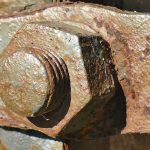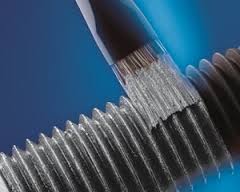 Thread galling is a common yet a seldom understood fastener problem seen by engineers and fabricators. It occurs when pressure and friction cause bolt threads to seize to the threads of a nut or tapped hole. The fasteners are not just overly tight but “cold/contact” welded together.
Thread galling is a common yet a seldom understood fastener problem seen by engineers and fabricators. It occurs when pressure and friction cause bolt threads to seize to the threads of a nut or tapped hole. The fasteners are not just overly tight but “cold/contact” welded together.
The Culprits: Metal Fasteners
This generally happens to metal fasteners when their protective oxide layer is worn away during the installation process due to the increased pressure and heat between the contacting thread surfaces. With the absence of the oxide coating, the raw metal threads contact each other directly with no barrier, causing the the nut and bolt to “fuse” together. Prior to use, you inspect all fasteners, yet after installation they still fail. So how do you prevent this?
Galling Prevention
1) Install Slowly and Correctly
Slowing down the installation RPM speed can often reduce and even completely prevent galling issues. As the installation speed increases, so does friction – resulting in the heat production that can cause galling. Also, over-tightening can also increase friction and galling.
2) Use Lubrication and Coatings When Possible
Lubricating the internal and/or external threads reduces friction which is a primary element of galling. Always take into consideration the end use of the fasteners before selecting a lubricant. Applications where food or laboratory purity is a concern may make some lubricants unacceptable. In addition, the fastener installer must take into consideration changes in the torque-tension relationship due to the use of lubricants as over-tightening can also result in galling. Effective lubricants include:
- Molybdenum disulphide is a high temperature lubricant that can be used to prevent metallic contact and minimize abrading. This is typically used when normal lubricants and oils are not suitable for the temperatures of the application.
- Film lubricants containing silver, aluminum or copper can be used to decrease the coefficient of friction. Most anti-seize compounds applied at the assembly line contain these metal particles.
- Tribological coatings such as PTFE, PVDF, PFA and FEP are another option. These are fluoropolymer coatings that blend resins and fluoropolymer lubricants together in order to provide low friction, chemical, and corrosion resistance, as well as non-wetting and release or non-stick properties up to 550° F.
- Extreme pressure waxes may also be effective.
3) Fastener Thread Selection
A smoother surface texture will lead to less frictional resistance. Rolled threads usually offer smoother surfaces than cut threads which decreases the friction that can lead to galling. In addition, the use of coarse verses fine threads can also help. Coarse threads have a larger thread allowance, whereas fine threads have more friction generating surfaces.
4) Dissimilar Metals (Hardness)
Another technique to minimize galling is utilize materials of different hardness, for both the nut and the bolt. By doing so, only one materials is more likely to wear its protective oxide layer and hence preventing galling. However, caution must be taken that a galvanic coupling is not created from the dissimilar materials that could accelerate corrosion especially if the fasteners are exposed to liquid media.
Galling: It’s NOT Just an Installation Issue
Though stainless steel, aluminum and titanium are more prone to galling during fastener installation then some of the specialty alloys, it is not just an issue that occurs when you tighten a bolt. Thread friction can build over time and result in delayed galling.
